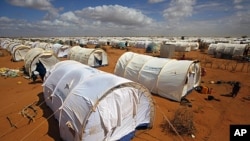The United Nations High Commissioner for Refugees says it will start moving Somali refugee families into a new area of Kenya’s overcrowded Dadaab refugee complex. The new site, known as Kambioos, is close to the Hagadera camp, one of Dadaab’s three refugee camps.
More than 70,000 Somalis fleeing drought, famine and conflict have arrived at Kenya’s Dadaab camp over the past two months, pushing the overall population to about 440,000. The new influx adds to the existing chaotic conditions of the overcrowded refugee complex.
When Dadaab was constructed 20 years ago, it was designed to accommodate about 90,000 people. It has since grown to be the world’s largest refugee camp and, in terms of its population, is now Kenya’s fourth largest city.
UNHCR spokesman Adrian Edwards says the camp is bursting with refugees and cannot accommodate more. So, new arrivals are forced to live in squalid, makeshift conditions on its periphery.
He says the UN refugee agency is working to ease this shelter crisis by transferring the first of several thousand Somali refugee families into a new site, which is planned to accommodate 90,000 people.
“Tents and infrastructure are being put in place and will provide much needed shelter and services," he said. "We are currently seeing 1,500 people arriving on average every single day. Many have been settling spontaneously on the outskirts of Ifo, Dagahaley and Hagadera, the three component camps of the complex. As well as needing food and water, these new arrivals urgently need proper shelter, medical help and other basic aid.”
Meanwhile, Edwards says the relocation of people into the new Ifo III Extension, which began July 25, is continuing. He says more than 15,000 refugees, so far, have been moved into the site.
In another bid to ease the overcrowding in Dadaab, Edwards says the UNHCR and its partners are working to expand an area, formerly known as Ifo II, to shelter the ever-increasing refugee arrivals.
The Ifo II camp is a sensitive matter between the UNHCR and Kenyan government. Construction began nearly two years ago, as an expansion of the Ifo camp at Dadaab. It was meant to decongest the overcrowding in the three existing camps.
The camp has room for 40,000 people. It has brick houses, clean running water and even school buildings. But, it remains empty. The UNHCR has been urging the Kenyan government to open Ifo II for the past two years. But, the government has refused to allow refugees to live in permanent structures, citing security concerns.
While this issue remains unresolved, UNHCR spokesman Edwards says the Ifo II Extension is undergoing emergency work to increase its capacity.
“If you just recall at the time that work stopped or that movement stopped on Ifo II early this year, the capacity was 40,000 people, we need to have space for significantly more," he said. "Tents are already being pitched in Ifo II and we expect the first families to move in soon, with priority given to the extremely vulnerable.”
Edwards says the UNHCR has moved thousands of tents to Dadaab over the current crisis, but it is still not enough for the growing refugee population. It says it urgently needs 45,000 more tents and is appealing to donors to respond more generously to its $145 million appeal.
More than 12 million people face hunger and starvation in the Horn of Africa. The UNHCR calls the drought, which is gripping Ethiopia, Kenya, Djibouti, and Somalia, the worst humanitarian crisis in the world. Somalia is particularly hard hit. The United Nations has officially declared several regions in south-central Somalia famine zones.
Somali Refugees Move to New Site in Kenya












